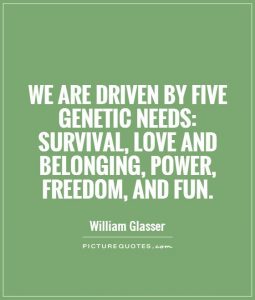Every person who ever explained the results of a personality handwriting analysis knows that it is more fun to share the positive traits than the negative ones.
It is easy tell someone they are generous. But, what about selfish and stingy?
This short article talks about a simple mental process you can ask yourself to turn the delivery of the most critical type of negative personality trait into something compassionate and perhaps life-altering for the listener.

I recently wrote an article “How to Share Negative Traits in a Very Nice Way” in which I describe some ways to soften the information by turning statements into questions.
In that article, I explained an approach that uses information gathering and questions instead of the usual information sharing technique to create ease in rapport with the person whose handwriting you are analyzing.
And, to do that you must be able to actually understand the positive aspects of a negative personality trait.
Some are much harder to figure out than others. Unspeakable crimes are just things most of us see on TV shows and we will leave the FBI criminal profilers to speculate and write books. But in our own life, there are totally unacceptable behaviors that people do every day (lie, cheat, steal, punch, kick, etc.)
A great thing about handwriting analysis is that almost every negative trait can be reframed as something useful to the person’s own life path… but you have to have some compassion and often tons of creativity to find that fresh perspective. I discovered this profound shift in perspective when I studied the process of time line therapy and NLP based questions in the context of therapy.
We were taught to ask about a particularly negative circumstance a client might had found himself in this specific question, “What was the positive intent of that choice?”
Normally, this ANSWER (positive intention) relates to a person’s sense safety, security, or survival.
Remember this: People have deep need to survive.

As people grow up, people ask themselves (either consciously or subconsciously), “How do I survive?” and “How do I get past this terrible situation?”
Through the survival strategies they create, they develop traits that can be positive and can be negative.
Almost every negative trait (even for the most psychotic people at some level) arises from thinking, “If I adopt this personality trait, if I adopt this behavior, my propensity to survive will increase.”
Think about all the popular TV shows like Criminal Minds and CSI with the darkest profiles of people and criminals on them. You may wonder, “How in the world does kidnapping or doing the things that they do help them survive?” In their very warped minds, they feel their actions are paths to get them some sort of emotional fulfillment and, indeed, survival is one of those.
In this article, I am not going to show you how to identify these traits in the handwriting. I’m operating with the pre-supposition that you already have some basic knowledge of handwriting analysis and the methodology we teach here at Handwriting University. If you do not, you might want to hear a clip from the Certification Course on the idea of criminal minds.
Here I’m going to go into more detail on how the negative traits develop so that you can better grasp the concept of why people develop such NEGATIVE traits, communicate them more gently and thus have enough rapport to help them change. Because after all, helping people transform is the biggest reason of all to study handwriting analysis.
How Unique Personality Traits Are Developed In Humans

There is a lot of debate about nature versus nurture (whether people are “born that way” or develop their traits). For the purpose of easing a conversation about negative traits, let’s assume that the traits are learned.
Making that assumption allows you to shift the focus from the negative trait to the reason the trait was created.
Each person is born with the strong urge to do whatever it takes to survive and to survive in the best way they possibly can. It is instinctual. Our bodies and brains are constantly motivated by our survival instincts (usually) for our best interests.
That impulse, that instinct to survive is very important to understand in childhood because when a young person devises a strategy (even subconsciously devises a strategy) that seems to help them survive, that child will repeat that strategy again and again when faced with similar situations.
And, that pattern of behavior will continue into adulthood and will become a part of that person’s personality and way of interacting with the world.
With every person, in every instance, we can always agree that at some point the person was born. Every, single time. No exceptions.
So, in a pinch if you are looking for a place to start where you’ll get agreement, you can say, “So, you were born, right?”
Your client may be puzzled by that question but will answer “yes” and with that agreement you’ve gotten a little openness.
Then, you can proceed with a possible story or scenario.
------------ Special Newsletter Reader Offer ------------

Visit the discount page now.
Events
You may or may not end up discussing the specific events that formed these patterns or traits, but you can assume the events are there. These “root causes” are often the key to an effective therapy session or even hypnosis or time-line therapy. Something was at cause.
The important thing is to get the person thinking in those terms of “When did I make that decision to become this way.” Cause is key!
You can say: “There’s an event that happened in your past when you felt you needed to protect yourself in some way and because of that, you developed this trait.”
You can give a possible example of how that might work.
You can start with something general like, “You know how after a child touches a hot stove and gets burned, that child will not touch the stove again?” You’ll get a nod or a yes (agreement!) and you can continue, “Well, this is like that…” You can pause to let it sink in, or you can continue with more specifics if you like.
The more times you can get agreement in your conversation, the more open the person being analyzed is likely to be, and that is especially important when you are sharing traits that can be seen as negative.
So, seek those opportunities for agreement. Shifting the focus back to the events that occurred is a great technique to use.
Let’s look at a few specific traits to understand better what I mean.
In “How to Share Negative Traits in a Very Nice Way” I went into some detail about Fear of Success, Domineering, and Lying. Refer back to that article about those traits.
In this article, I will go into a bit more detail about Shyness, Stinger (Issues with the Opposite Sex), and Pride.
Shyness

Again, there can be debate about whether a person is born shy or not. I had a person who justified his shyness by his myers briggs label. “I’m an INTJ, therefore I still still have voices in my head telling my I am not good enough.”
Don’t use labels as an excuse for keeping bad mental habits.
In this context, it does not matter because what helps you have a productive conversation is to help a person see how Shyness could have been a survival strategy in the past… and is it needed now?
So, a person is born, and there may have been events that happened along the way that might make them have a reaction to situations that we call Shyness.
A typical scenario that you can use as an example is a person may have gotten up on stage in a talent show or something and had people in the audience laugh at them; so, they decided it would be safer (a better way to survive) if they did not put themselves out there, if they would blend into the background and not be noticed for ridicule.
You can say, “A lot of people who have Shyness have some event in the past when they reached out. They were vulnerable and they got laughed at. They got mocked, and they were not approved. Did something like that happen in your past where you felt that you were not being accepted and therefore the safest way to protect your ego was to withdraw?”
Or, “You felt it was safer to not even risk being noticed.”
The key points to keep in mind with Shyness are the risk of being noticed and the risk of rejection.
Take yourself back to the events that may trigger the Shyness survival mechanism, and they will usually boil down to strategies to avoid the risk of being noticed or the risk of rejection.
Stinger (Intermitten Reinforcement Complex)

(Expanded definition of this trait in 2015. Go here to read it.
http://handwritinguniversity.com/members/weekly-newsletters/a-bad-case-of-the-stingers/
This one is something people often look for in dating situations.
It reveals, as you know, unresolved issues with the opposite gender.
This is one trait in which we clearly define that there is an underlying, unresolved issue. It is a part of the definition of the trait.
It is tricky to share information about this trait because if they are in a relationship now, they will deny that they have the issue. They may say, “Well, I used to be that way. I used to have resentment, but I’m in a great relationship now, and we don’t have that problem.”
And, all the attraction hormones are the same thing that will turn to anger later when they do not get their way in the relationship.
You can say, “I’m noticing you have a unique attraction to certain members of the opposite gender, ant that attraction is not always healthy. Sometimes you pick people who are hard to get.”
Often, you’ll get a reaction like, “Yeah, I like the bad boys/girls.”
You can then explain that this attraction can sometimes turn into a little bit of unresolved resentment that can create problems with making a healthy relationship.
You can continue with a very powerful phrase, “Sometimes you may start fights just to see who is stronger.”
Excessive Pride & Vanity.

(201 Trait Dictionary owners: click here to learn more about the “Pride and Dignity” personality trait. If you do not have access to the 201 Trait dictionary, click here to get registered for full access.)
This is probably my MOST annoying to be around negative trait of the last couple years.
I’ve found that people who have vanity have no place in my inner circle. It is very difficult to deal with. It is not only annoying but also tends to be accompanied with a high level of deceit, and it is a condescending attitude.
It is sort of like, “I’m better than you, and people should treat me like royalty.”
So, how could that be a survival mechanism?
Perhaps it was a part of that person’s family or community culture and so to survive and fit in, they adopted it.
It can also arise from insecurity. They have a low self-esteem and actually see themselves in a low light; so, to survive in a world where they actually see most people as being better than themselves, they create a false ego.

That false, more inflated, ego creates a perception of how others should treat them.
So, how can you present that in a friendly way?
I usually say something along the lines of: “You have a unique perception of your self-worth, and because of that, I think you find a lot of people don’t stack up to your criteria. So then there’s a slight feeling that you’re a little bit better than other people, and they need to step up their game and treat you better.”
If you’ve got enough rapport to be honest with them, you can say, “I must say that trait comes with a little bit of self-delusion and so you are constantly feeling that others are not respecting you as much as you deserve. That feeling has a little to do with your insecurity because your true self-image does not match up with your perception of how others should treat you.”
I usually use my hands and as I say “true self-image,” I indicate a low point. When I say, “perception of how others should treat you,” I move my hand up or use my other hand to indicate the distance, the gap between the two.

When people have pride, they have an artificially inflated ego with underlying self-esteem issues. They annoy me… but I’m trying to have compassion.
Summary
When you clearly understand the variety of underlying reasons a person would adopt a trait for survival, you are better able to communicate in a way so that what you are saying can be heard and absorbed.
Basically, people are attracted toward pleasure and motivated away from pain.
Ask yourself, “How could they have developed that trait? What could have happened?” By simply asking that question to yourself or to the person you are analyzing, you will have at least one (and maybe two or three) possible answers.
By asking that, you remove the responsibility from them. You are not blaming them or judging them or making them bad or wrong. You are indicating that you are seeking to understand and help them understand what is going on, and you will not get defensiveness. You will generally get curiosity as a response, and you will be able to fully share the information you see in the handwriting – but in a palatable way.
If you are actively engaging in counseling or even working on changing yourself, this process of finding the root cause and reframing using language is key to success and lasting change. It is covered in over 23 modules of the new program Unstoppable You. 23 Videos and even guided meditation tracks to download.

------------ Special Newsletter Reader Offer ------------

Visit the discount page now.

Permalink
very nice thoughts on stinger.
Thank you Sir.
Permalink
very pleased to heard